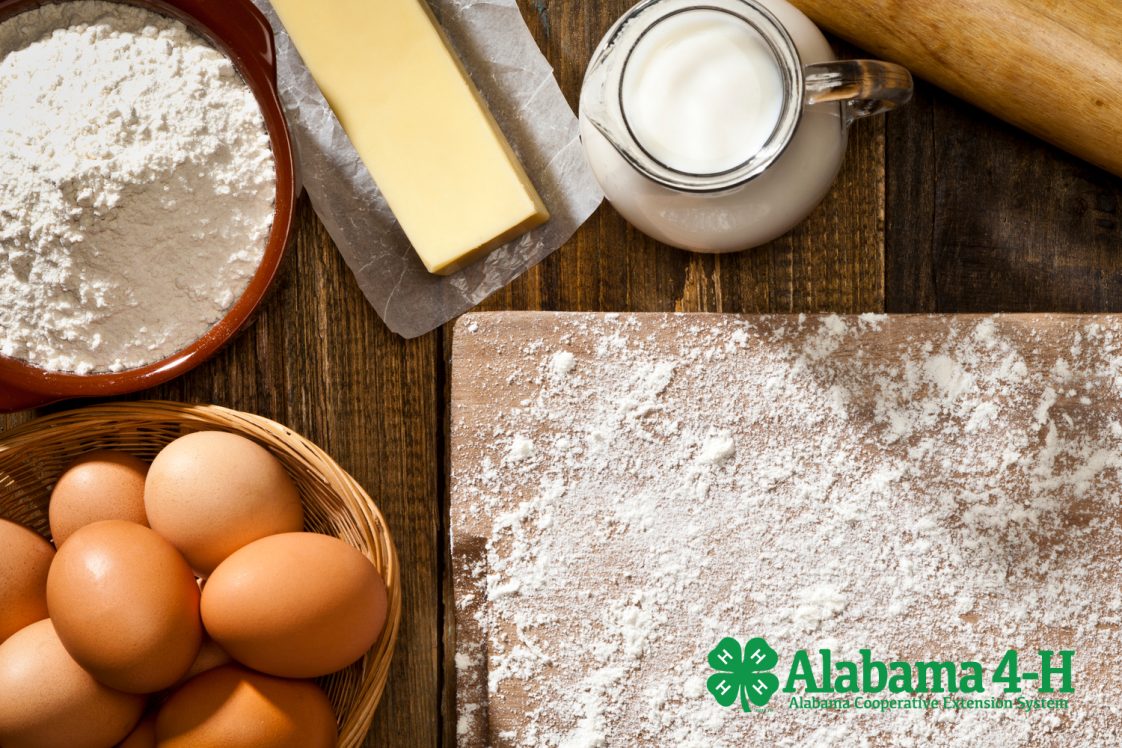Alabama 4-H

Have you ever imagined that you were a famous pastry chef? You stand in front of an audience, using your knowledge and creativity to prepare wonderful and amazing dishes. 4-H Bake Off is your chance to do that—at least on an introductory level.
2023–2024 Circus Theme
What You Will Do in 4-H Bake Off
- Exhibit your skills with different cooking techniques.
- Share a favorite traditional or original recipe.
- Show how to prepare a tasty and healthy dish.
What You Will Learn
Besides getting to try new and tasty dishes, 4-H Bake Off will make you a smarter and more imaginative chef. It also will make your meals and snacks healthier and more interesting.
- To make good food decisions, making every dish part of a healthy diet.
- To make shopping lists and food menus.
- To demonstrate how well you handle yourself in the kitchen.
- Good culinary techniques.
- How to teach others by presenting your knowledge before a live audience.
Levels of Competition
For details on eligibility, see the General Event Policy.
Junior Level I: 9 to 11 years old on December 31 of the current calendar year (compete only at local and regional levels).
Intermediate: 12 to 13 years old on December 31 of the current calendar year (compete only at local and regional levels).
Senior Level I: 14 to 15 years old on December 31 of the current calendar year.
Senior Level II: 16 to 18 years old on December 31 of the current calendar year.
Refer to Alabama 4-H Competitive Events on the Alabama Extension website (www.aces.edu) to review the General Contest Policy and the Age & Eligibility Chart.
The Rules for 4-H Bake Off
Note: Due to peanut allergies, no peanut products are allowed.
Each participant must plan and prepare an attractive exhibit of baked foods to display on a tabletop no larger than 3 feet deep and 3 feet wide.
- Participants will include in the exhibit baked products from two of the five categories:
- Cookie
- Cake or Cupcakes
- Quick Bread (muffins, biscuits, cornbread, banana bread)
- Brownie or Bar
- No prepared mixes allowed.
- Recipes for the products exhibited must either be included in the exhibit or copies of the recipes must be available at the exhibits.
- Each exhibit should include a 12″ x 12″ poster with the title of the exhibit. The poster should be supported by a table easel or constructed to stand on its own.
- The 4-H member will answer questions about the exhibit, food preparation, and the place of breads in a balanced diet.
- The 4-H member should be neatly dressed in clean clothes and shoes.
Each participant will be judged in these areas:
- Exhibitor (4-H member). 20 points. General appearance, enthusiasm, knowledge of exhibit, neatness, and manners
- Exhibit. 55 points. Theme, attractiveness, creativity, appearance, and taste
- Subject Matter. 25 points. Educational, timely, and with stress on nutrition.
Disqualifications:
- Using a board larger than 12″ x 12″ (no trifold boards).
- Using a prepared (boxed) mix as an ingredient.
- Senior Level 4-H member not submitting a community service report.
Community Service
Telling a great story showcasing projects at a community library, speaking at a local nursing home, or organizing a community cooking or building blocks workshop are great opportunities to serve others. Serving others helps build your academic skills, learn civic responsibility, and develop leadership. It may also give you a good opportunity to meet new people, publicize 4-H, and practice your communication skills. Alabama 4-H is now requiring all Senior Level 4-H members to add a community service component to all 4-H Competitive Events. Each Senior Level 4-H member will have to complete the 4-H Community Service Report as a part of his or her project. 4-H members will be disqualified if the community service report is not included.
You must decide what service you can provide and not have a parent or 4-H leader make this decision for you. Groups of young people are encouraged to work together to discover how they can serve their community.
Career Connections Culinary Job Descriptions
Skills developed through this project have direct connections to exciting and rewarding careers. Restaurants, hotels, and other food service industries often employ three distinct types of employees—chefs, cooks, and food preparation workers.
- Chefs are responsible for directing the activities of other kitchen workers, planning menus, creating recipes, ordering food and supplies, and some specific cooking duties. They are typically the most experienced and best educated members of the staff.
- Cooks are responsible for the day-to-day food preparation at the restaurant or facility. Depending on the size of the facility, there may be several cooks, each responsible for a different part of the menu or a different type of food. For example, there are fry cooks, vegetable cooks, pastry cooks, and other specialties.
- Food Preparation Workers are under the supervision of chefs and cooks and typically perform less skilled duties. For example, they may chop vegetables, prepare salads, and prepare materials used by the restaurant’s chefs and cooks.
- Food Service Managers are often responsible for many of the behind-the- scenes activities that keep the establishment going. Food service managers have responsibilities ranging from ordering food and supplies, selecting menu items and determining their prices, and ensuring the high quality of food preparation and service. They are frequently responsible for administrative tasks.
Documents
- Download a PDF of 4-H Bake Off Score Sheet, 4HYD-2241.
- Download a PDF of Community Service Report, 4HYD-2241.
Joy Scott, Extension Specialist, 4-H and Youth Development, Auburn University.
Revised July 2023, 4-H Bake Off, 4HYD-2241

